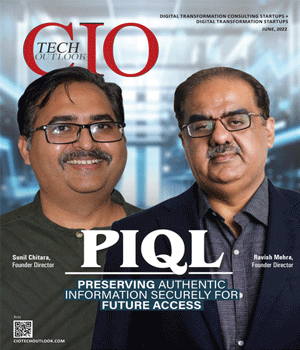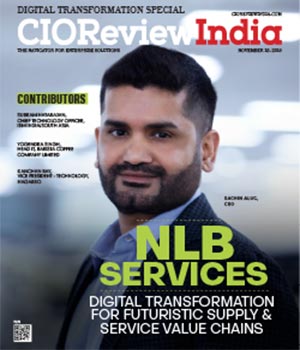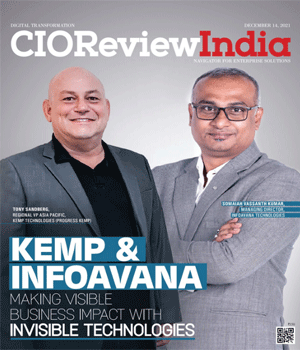
Technologies that will boost Digitalization across Industries
Sanjay Agrawal, Technology Head, Hitachi Vantara | Friday, 06 May 2022, 14:30 IST
 The pandemic forced companies worldwide to transform their businesses, as consumers moved to online channels, accelerating digital technology adoption. About 74 percent of businesses accelerated their digital technology adoption by months or years, found a KPMG survey. About 66 percent of those surveyed adopted automation aided by Machine Learning (ML) and Artificial Intelligence (AI) to create new workforce models.
The pandemic forced companies worldwide to transform their businesses, as consumers moved to online channels, accelerating digital technology adoption. About 74 percent of businesses accelerated their digital technology adoption by months or years, found a KPMG survey. About 66 percent of those surveyed adopted automation aided by Machine Learning (ML) and Artificial Intelligence (AI) to create new workforce models.
Companies underwent a digital transformation to continue functioning, stay ahead of the competition, and maintain market share during the pandemic. Industry leaders say that this transformation is here to stay and will pave the way for global industry adoption of emerging and disruptive technologies. In the long run, this digitalization is expected to pave the way for improved business output with maximum efficiency and minimum wastage.
Automating for the future
For businesses, it is essential to identify the change in advance and adapt accordingly. Historically, the manufacturing sector has been the driver for new technology adoption and course correction strategies. Today, this transformation is led by industry 4.0, revolutionizing the way companies manufacture, improve, and distribute their products. It is being done by integrating the latest technologies, such as the Internet of Things (IoT), cloud computing, AI/ML, and analytics into production facilities and operations. Manufacturing companies are using IoT assets to connect machines and systems together, enabling real-time asset monitoring that achieves zero defects and reduces downtime, emissions, and accidents at production facilities.
Automation in the industrial automation market is expected to grow at a CAGR of 9.3 percent from 2020 to 2027 to reach USD 306.2 billion by 2027, suggests a report by Meticulous Research.
Automation has enabled improved decision-making aided by real-time data on various metrics resulting in improved productivity, sustainability, and the use of fewer resources. In the automotive industry, for example, the use of advanced automation technologies, such as machine vision, collaborative robots, AI for driverless/autonomous cars, and cognitive computing in IoT-connected cars have become the norm.
Boosting efficiency using sensor IoT
The use of easy and quick integrated sensors and devices that monitor equipment and produce user-friendly data, graphics, and more in real-time helps automotive manufacturers connect production lines more efficiently. Managing materials in inventory or at a workstation using monitoring devices helps reduce downtime. Real-time data on equipment run times allows organizations to adjust workflows at their manufacturing units, reduce changeovers or track equipment performance to plan maintenance. It helps understand lead times and provides more accurate estimates and timelines.
The increased focus on automation and the need for high-quality data is also driving the demand for smart sensors in the IoT space. An analysis by Persistence Market Research for 2022 finds that the sensor market is set to expand with greater adoption of IoT. The market is expected to grow at a CAGR of 13 percent from 2022 to 2025, with a surpassed valuation of USD 380 million by the end of 2022.
The demand shows how business sectors are increasingly finding IoT-based solutions to meet their requirements. A sensor’s ability to take measurements and collect data, process information, run programs, and communicate with other devices makes them a key component of IoT. At a manufacturing unit, a sensor IoT could predict malfunctions and detect external objects and people in specific areas. The collected data points become the basics for analysis of the unit’s performance, helping business leaders develop new business strategies, optimize resources, improve productivity, and increase enterprise security. A report by Mordor intelligence indicates that the need for IoT sensors for the machine-to-machine interface alone is expected to be at 24per cent each year through 2026.
In the coming decade, the sensors will become more reliable with research being carried out to improve their working range, response time, performance, durability, ease of integration with other equipment, and intercommunication capabilities.
Improving analytics with AI/ML
In the healthcare sector, AI/ML has enabled better pattern identification by providing actionable insights. It is now possible to make predictions driven by data within a few seconds without human intervention.
Healthcare professionals are using digital tools to predict epidemics and chronic diseases but are also using them to optimize resources and staff allocations at hospitals. Predictive analytics enables healthcare institutions to streamline their medical resource allocation by predicting the patient flow, and rescheduling staff, to better manage service and rate of appointments.
The BFSI sector is also leveraging AI/ML analytics as they leverage these data-driven smart insights to price their products better, improve efficiency, tackle fraud and improve enforcement. The insurance sector uses AI/ML for claims processing, underwriting, and fraud detection. Technology companies also leverage AI/ML to predict cyber-attacks, improve infrastructure security, enhance customer acquisition and engagement, enterprise operations, and risk management services.
For bank customers, AI/ML has enabled a hyper-personalized banking experience, eliminating waiting queues altogether and providing round-the-clock service. AI is also used to improve customer experience with realistic interactive interfaces such as chatbots.
As governments worldwide begin the rollout of networks based on 5G technology, we can expect to improve the data processing rate of AI/ML systems, blockchains, and virtual and augmented reality systems drastically. These megatrends are expected to revolutionize the workplace and the world as we know it, making it vital for industries across to boost their digitization.
CIO Viewpoint
The Constantly Evolving Technology Landscape in...
By Janifha Evangeline
Navigating the Digitalization of Mining Industry
By Janifha Evangeline
How To Achieve An Effective Digital Transformation
By Yogendra Singh, Head-IT/SAP, Barista Coffee Company Limited
CXO Insights
No-code platforms: Enterprise-wide Adoption...
By Rahul Murthi, Director at Acies
Unleashing the Potential of IT in Engineering...
By Gyan Pandey, Head - Digital/CDO, Voltas
Low Code and Artificial Intelligence - The...



.jpg)

.jpg)





